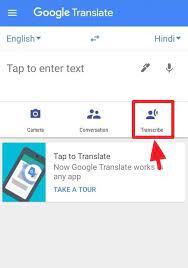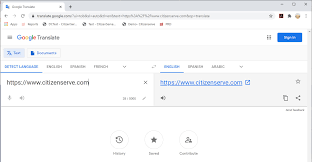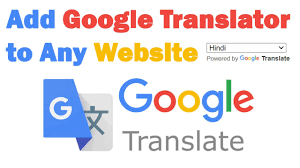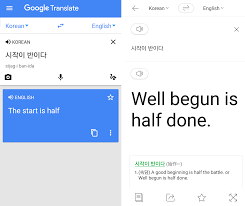Google Translate Voice to Text: Breaking Language Barriers with Technology
In today’s interconnected world, effective communication is key. However, language barriers often hinder our ability to connect with others from different cultures and backgrounds. Thanks to advancements in technology, tools like Google Translate Voice to Text have emerged as powerful solutions, bridging the gap between languages and enabling seamless communication.
Google Translate Voice to Text is a feature within the popular Google Translate platform that allows users to convert spoken words into written text in real-time. This innovative tool utilizes automatic speech recognition (ASR) technology, combined with sophisticated algorithms and machine learning techniques, to accurately transcribe spoken words into text across multiple languages.
One of the standout features of Google Translate Voice to Text is its versatility. It supports a wide range of languages, including commonly spoken ones like English, Spanish, French, German, Chinese, Japanese, and many more. This expansive language support makes it a valuable tool for travelers, international business professionals, language learners, and anyone seeking instant translation assistance.
The user experience offered by Google Translate Voice to Text is designed with simplicity in mind. Users can easily access the feature through the Google Translate app or website by selecting the microphone icon. Once activated, users can speak directly into their device’s microphone or headset while the tool transcribes their speech into written text in real-time.
The accuracy of Google Translate Voice to Text has significantly improved over time due to ongoing advancements in ASR technology. While minor errors may still occur occasionally due to regional accents or background noise interference during transcription, overall accuracy continues to improve as the underlying algorithms learn from user interactions and feedback.
The applications for Google Translate Voice to Text are vast and varied. For travelers exploring foreign countries where language barriers can be a challenge, this tool can help facilitate communication with locals for directions or general inquiries. International business professionals can use it during meetings or conferences when dealing with foreign colleagues who may not speak their language fluently. Language learners can practice pronunciation and improve their speaking skills by comparing their spoken words to the transcribed text.
Google Translate Voice to Text is not without its limitations, however. It is important to note that it may struggle with complex or technical vocabulary, idiomatic expressions, or nuanced linguistic nuances that require human interpretation. Therefore, it is always recommended to use the tool as a helpful aid rather than a definitive translation solution in critical or sensitive contexts.
In conclusion, Google Translate Voice to Text represents a significant milestone in breaking down language barriers and promoting global communication. With its user-friendly interface, extensive language support, and continuous advancements in accuracy, this tool has become an invaluable resource for individuals and businesses alike. As technology continues to evolve, we can expect even more sophisticated solutions that will revolutionize our ability to connect with others across languages and cultures.
7 Frequently Asked Questions About Google Translate Voice to Text
- How do I use Google Translate Voice to Text?
- What languages does Google Translate Voice to Text support?
- Is there a cost associated with using Google Translate Voice to Text?
- How accurate is the translation provided by Google Translate Voice to Text?
- Is there a way to customize the translation results from Google Translate Voice to Text?
- Does Google Translate Voice to Text work offline?
- Can I use my own voice recordings with Google Translate Voice to Text?
How do I use Google Translate Voice to Text?
Using Google Translate Voice to Text is simple and convenient. Here’s a step-by-step guide on how to use this feature:
- Download the Google Translate app: If you don’t have it already, download the Google Translate app from your device’s app store. It is available for both iOS and Android devices.
- Open the Google Translate app: Once installed, open the app on your device.
- Select the target language: Before using Voice to Text, make sure you have selected the language you want to translate into. You can choose from a wide range of languages by tapping on the language drop-down menu at the top of the screen.
- Tap on the microphone icon: In the main interface of the app, you will see a microphone icon at the bottom center of the screen. Tap on it to activate Voice to Text mode.
- Allow microphone access: If prompted, grant permission for the app to access your device’s microphone.
- Start speaking: Once in Voice to Text mode, start speaking clearly into your device’s microphone or headset. You can speak in short phrases or complete sentences.
- Observe real-time transcription: As you speak, Google Translate will transcribe your speech into written text in real-time on the screen. You can observe this transcription as it appears.
- Pause or stop when needed: If you need to pause while speaking or want to stop altogether, simply tap on the microphone icon again to pause or end Voice to Text mode.
- Review and edit if necessary: After completing your speech, review the transcribed text for accuracy. If needed, you can make any necessary edits or adjustments before using or sharing it.
- Use translated text as needed: The transcribed text can be used for various purposes such as communication with others who don’t speak your language, practicing pronunciation and speaking skills, or simply understanding spoken content more effectively.
Remember that while Google Translate Voice to Text is a powerful tool, it may have limitations and occasional errors. It is always recommended to use it as a helpful aid rather than relying solely on it for critical or sensitive translations.
What languages does Google Translate Voice to Text support?
Google Translate Voice to Text supports a wide range of languages, including but not limited to:
- English
- Spanish
- French
- German
- Italian
- Portuguese
- Russian
- Chinese (Simplified and Traditional)
- Japanese
- Korean
- Arabic
- Hindi
- Bengali
- Indonesian
- Turkish
These are just a few examples, and the list continues to expand as Google continuously updates and enhances its translation services. Google Translate Voice to Text strives to provide support for as many languages as possible to ensure its users can communicate effortlessly across different cultures and linguistic backgrounds.
It’s important to note that the accuracy and availability of specific language support may vary depending on the complexity of the language and ongoing updates made by Google’s language processing algorithms.
For an up-to-date list of supported languages, it is recommended to visit the official Google Translate website or refer to the Google Translate app for the most comprehensive information regarding language support for Voice to Text functionality.
Is there a cost associated with using Google Translate Voice to Text?
Google Translate Voice to Text is available for free to users. It is part of the Google Translate platform, which offers a range of language translation services and tools. Users can access Google Translate Voice to Text through the Google Translate app or website without any additional charges. However, it is worth noting that data usage charges may apply if you are using the feature on a mobile device and are not connected to a Wi-Fi network. Additionally, some features within Google Translate, such as offline translation or certain advanced functionalities, may require a paid subscription or in-app purchases. It’s always recommended to check the specific terms and conditions of the Google Translate service for any potential costs associated with additional features or usage beyond the basic Voice to Text functionality.
How accurate is the translation provided by Google Translate Voice to Text?
The accuracy of translations provided by Google Translate Voice to Text has improved significantly over the years, thanks to advancements in automatic speech recognition (ASR) technology and machine learning algorithms. However, it is important to note that the accuracy may vary depending on various factors.
For commonly spoken languages and straightforward phrases, Google Translate Voice to Text generally provides fairly accurate translations. It can effectively capture the main ideas and convey the intended message. However, it is important to keep in mind that no machine translation system is perfect, and errors or inaccuracies may still occur.
Certain factors can affect the accuracy of translations. Regional accents, dialects, or speech patterns that deviate from standard pronunciations may pose challenges for the tool. Background noise or poor audio quality can also impact accuracy. Additionally, complex vocabulary, idiomatic expressions, or nuanced linguistic nuances may be difficult for the tool to accurately interpret.
Google continues to work on improving the accuracy of its translation services by collecting user feedback and utilizing machine learning techniques. As more users interact with the tool and provide feedback on translations, the algorithms can learn and adapt over time.
While Google Translate Voice to Text can be a valuable aid in overcoming language barriers and facilitating communication, it is always advisable to review and verify translations for critical or sensitive contexts. For important documents or professional use cases, consulting with human translators or linguists is recommended to ensure precise and accurate translations.
Overall, Google Translate Voice to Text offers a convenient solution for quick translations on-the-go but should be used as a helpful tool rather than a definitive translation source in situations where utmost accuracy is required.
Is there a way to customize the translation results from Google Translate Voice to Text?
Currently, Google Translate Voice to Text does not offer customization options for translation results. The tool’s functionality is primarily focused on providing real-time transcription of spoken words into text across multiple languages. While it strives to deliver accurate results, the translations generated by the tool are based on algorithms and machine learning models that may not always capture the full context or nuances of a conversation.
If you require more precise or customized translations, it is recommended to consult a professional translator or utilize other translation services that offer human expertise. These options can provide a higher level of accuracy and ensure that the translated text aligns with your specific needs and requirements.
It’s worth noting that Google Translate as a whole offers additional features and customization options for written translations, such as the ability to select alternate translations, suggest improvements, and provide feedback on translation quality. However, these features are currently not available within the Voice to Text functionality specifically.
Does Google Translate Voice to Text work offline?
Yes, Google Translate Voice to Text does have limited offline functionality. While the feature primarily relies on an internet connection to provide real-time transcription and translation, Google Translate allows users to download certain language packs for offline use.
By downloading specific language packs in advance, users can access basic translation and transcription capabilities even when they are not connected to the internet. However, it’s important to note that the offline functionality is more limited compared to the online version, as it does not offer the same level of accuracy or support for all languages.
Additionally, offline mode does not support real-time transcription; instead, users will need to record their speech and then receive a written translation once they regain an internet connection.
To utilize offline functionality in Google Translate Voice to Text, users can go to the app settings and select the “Offline Translation” option. From there, they can download the desired language packs for offline use.
While offline mode can be a useful feature when traveling or in areas with limited internet access, it’s worth considering its limitations and planning accordingly. For optimal performance and access to a broader range of features and languages, an internet connection is recommended.
Can I use my own voice recordings with Google Translate Voice to Text?
As of now, Google Translate Voice to Text does not support the use of personal voice recordings for transcription. The feature is designed to convert spoken words in real-time as you speak into the microphone or headset connected to your device. It relies on the integration of automatic speech recognition (ASR) technology within the Google Translate app or website.
While you cannot directly upload and transcribe your own voice recordings using Google Translate Voice to Text, there are alternative methods available. You can play your recorded audio through a speaker while using the tool to capture and transcribe it in real-time. However, keep in mind that this method may introduce additional background noise or audio quality issues that could affect transcription accuracy.
It’s worth noting that Google offers other services, such as Google Cloud Speech-to-Text API, which allow developers to integrate speech recognition capabilities into their applications and work with pre-recorded audio files. These services are more suited for developers and require technical knowledge for implementation.
If you specifically need to transcribe personal voice recordings, there are dedicated transcription services available that specialize in converting audio files into written text. These services often utilize advanced speech recognition technology combined with human review to ensure accuracy. It’s recommended to explore such transcription services if you have a specific need for transcribing personal voice recordings.
Remember that technology is constantly evolving, and future updates may bring new features and capabilities to Google Translate Voice to Text or other translation tools. Stay tuned for any developments in this area as they may provide more options for working with personal voice recordings in the future.




